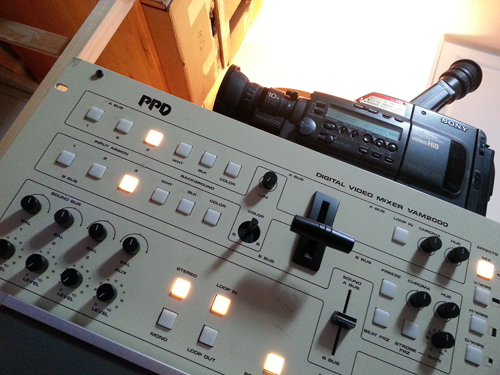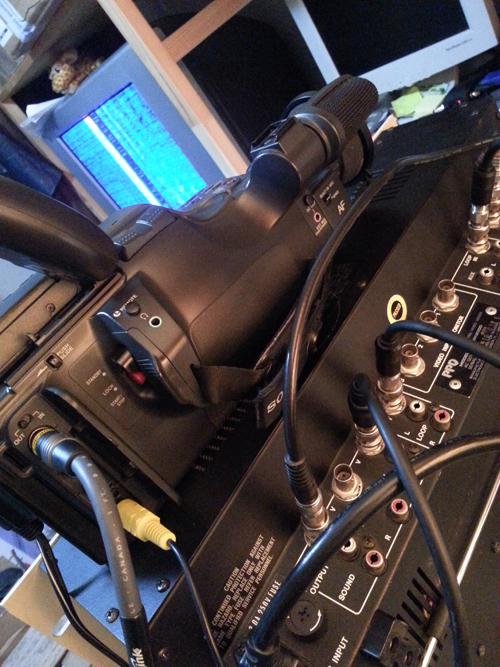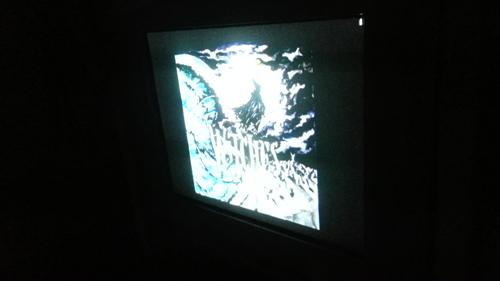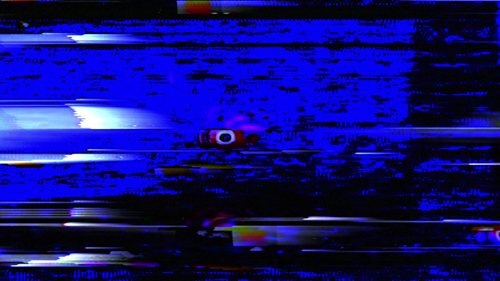Making-of: Dante Tomaselli Interview Video Teaser
When I interview a composer, I tend to make a short teaser video that either contains a mix of music and our Q&A, or just the Q&A, as was done a few months ago with John Murphy, in which voice audio was sent into an oscilloscope, the visuals filmed off the screen, and the footage layered, colorized, and finalized in Adobe Premiere.
For my written Q&A with director-writer-producer-composer Dante Tomaselli, I thought a short video teaser might be appropriate, especially since I wanted to have fun with a Sony camcorder I haven’t touched in years.
The concept was to visually go through each of Tomaselli’s prior quartet of concept-albums, leading up to his latest work, Out-Of-Body Experience [OOBE], which is markedly different from his more abstract, immersive soundscapes.
The aim was to hint at the prior albums while a short cue from the current plays, building up to Simon Pritchard‘s fantastic cover art, a gorgeous painted work that evokes eerie 1960s album and book covers for tales strange, weird, and unsettling.
The main workflow was layering in treated stills between glitchy video, courtesy of a dying Sony CCD-V801 Hi8 camera, which I used regularly for fFIDA dance tapings between 1994-1995, among other things.
In the 1990s, the camera worked great, but by the early 2000’s it was showing the results of the rotten capacitors which plagued MANY electronic products of the period.
The lore of why gear from that period goes bad is simple: some schmuck stole a formula for electrolytic capacitors, and the knock-offs were sold for a fraction of the legit originals’ cost. Major consumer and computer manufacturers settled for the cheaper variety, unaware, like the thieving schmuck, that one key ingredient was missing.
Ergo, computers, cameras, VCRs, etc. started to go wonky, unable to output stable image or audio, and eventually rendering the gear itself into garbage. Basic consumer cameras and high-end prosumer editing gear turned to poo, which is why repairmen are highly reluctant to touch the gear, as capacitors vary in size, some accessible, some deeply embedded in circuit boards. The junk capacitors are little time bombs waiting to destroy gear, and my Sony is very much a victim… but that’s not necessarily a negative.
The bad is the camera’s ability to output a signal from whatever the lens is trained on is dwindling rapidly; in the early 2000s, the image was dirty; a few years later, glitchy, first in the S-VHS output, then the composite; then the camera could only lock onto an object under dim lighting because ‘bright’ lights made it go haywire; and then it just stopped being able to capture any discernible image.
The good is the sync – both vertical and horizontal – is so messed up, the camera outputs instant glitch material, but recording it is another matter because a recorder – digital or tape-based – needs some stable sync to attempt to lock onto the video without dead gaps.
The synchronizer in my Panasonic WJ-MX12 used to be able to lock and output a recordable signal, but the camera’s composite and S-VHS signals are so degraded, it’s beyond hope, but my Numark PPD VAM-2000 mixer has slightly better luck, hence footage I processed and posted last month:
<
<
Even though the V801’s gotten worse since that recording, I was able to get some images for the interview teaser video, and plenty of glitchy, rolling, roving, rippling rubbish.
To get that footage, the workflow was to display the OOBE album art on a CRT by outputting a JPEG from an old Dell Inspiron 5000’s S-VHS socket, film the image with the V801, send a combination of the V801’s Y (luminance) and C (chrominance) signals into a Showtime Video Ventures processor before the Numark mixer, and after routing the mixer into a Krohn-Hite audio filter, record the results to DVD-R.




It took a long, long while to find the right settings to get the V801 to ‘see’ the sun from the album art, partly because you have to wait 20 mins. for the camera to ‘warm up,’ and fiddle with the aperture, gain, and shutter speed, going back & forth until the camera finally shows something besides garbage in the viewfinder. Basically hoping to find a sweet spot that feels like a .005mm bandwidth in which that sun image appears, then slightly boosting the brightness to destabilize the image, which is how you get rolling, snapping video.




For the full covers of Tomaselli’s prior albums, the JPEGs were again displayed from the Dell to the CRT, and filmed with a Sony CCD-VX3 Hi8 camera, the prosumer 3-chip, which seems less likely to have been larded with garbage capacitors. The crisp images were again recorded to DVD-R, and all footage was captured in Premiere.



The assembly consists of layered glitch footage for the red-blue patterns, matted stills of the album covers, and interpolated glitch footage of the OOBE cover.




I’ve posted the teaser video on Vimeo and YouTube, where it looks fine, but relented an IGTV edition because it seems whatever algorithm Instagram applies to uploaded footage, it treats less detailed analogue-based material like amorphous blobs, and 90% of the detail from the glitchy video looked like a compressed GIF from 1986 (basically, shit). Seems rapid, flickering video is too challenging for Instagram’s compression machine.
Vimeo:
YouTube:
Coming soon: blog on the iconic Ikegami ITC-730A ENG tube camera + some video footage as a long-dormant camera was fired up.
Thanks for reading,
Mark R. Hasan, Editor
Big Head Amusement
